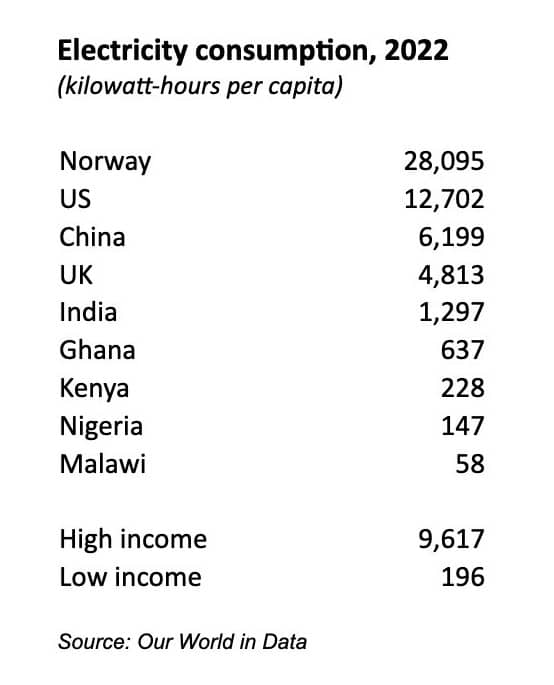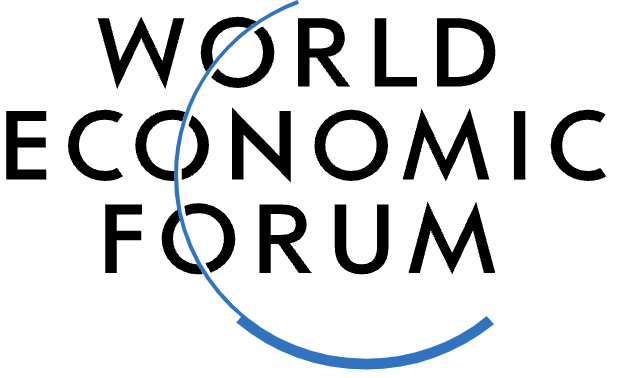Originally published by the World Economic Forum, November 7, 2023.
- We need unambiguous agreement that everyone on the planet deserves abundant energy.
- While higher energy consumption might sound counterproductive to climate goals, the two things can – in fact, must – coexist.
- At the COP28 Summit, world leaders must commit to a new Modern Energy Minimum of 1,000 kilowatt-hours per person per year.
Progress towards achieving many of the Sustainable Development Goals by 2030 has stagnated. Worries are mounting that we will not achieve our climate goals by 2050. In response, many are calling for urgent reforms to the multilateral development banks and the Bridgetown Initiative, which demands greater public and private capital for poor and vulnerable nations – and at reasonable lending rates. Frustration is growing.
At the COP26 climate summit in Glasgow two years ago, countries and companies tripped over themselves making massive – and unrealistic – pledges to mobilize billions of dollars to achieve global climate goals. While more money alone will not solve our problems, these unfulfilled promises are stoking resentment – and, increasingly, open anger – that threaten the global cooperation needed to tackle both poverty and climate. COP28 next month could restore goodwill, but only if aggressive climate action is matched by aggressive action on equity and economic development.
That’s why we need unambiguous agreement that everyone on the planet deserves abundant energy – what we’re referring to as a new Modern Energy Minimum. Here’s what that means and why it matters.
Prioritizing what really matters
While more money is absolutely needed, the central tension bubbling underneath every global summit is over equitable treatment, how money is spent and on which priorities. Multilateral bank reform, the Bridgetown Initiative and COP commitments such as the Loss and Damage Fund must all more forcefully address the expected development outcomes, beyond reducing carbon emissions.
New commitments must clarify how money can be spent to meet multiple objectives, especially those salient for poor nations. The South African Just Energy Transition Partnership doesn’t just aim to retire coal plants, but also to create jobs. The Global Energy Alliance for People and Planet (GEAPP) is not just spending $10 billion to expand energy access, but is committed to delivering a minimum level of energy use that enables livelihoods and greater economic opportunity. Successful climate policy requires equal ambition for development.
Meeting the Modern Energy Minimum
Energy is a key driver of the climate transition, as well the underlying basis for just and sustainable economic development. To bring first-time electricity to the 760 million people living without basic access is necessary, but insufficient. More than 3 billion people live without reliable energy – or enough of it. How much energy those 3 billion people consume is just as important if electrification is going to deliver development benefits. People need more than lighting in their homes; they must have sufficient energy to power modern appliances, to cook without damaging their health, and to earn a living via productive jobs. The key to driving economic growth and lifting people and countries out of poverty is higher energy consumption.
That’s why we support establishing a new Modern Energy Minimum of 1,000 kilowatt-hours per person per year. This level is higher than basic access and covers electricity used at home to raise living standards and in the wider economy to boost jobs and livelihoods. It correlates to an average per capita income of $2,500 per year, roughly the mid-point for lower-middle income status. Meeting the Modern Energy Minimum is just one step towards even higher levels of energy use and income. But it would enable billions of people to climb a higher rung on the ladder, taking them into the middle class.

Breaking the diplomatic deadlock
Higher energy consumption might sound counterproductive to climate goals. It’s true that the power sector is a principal driver of carbon emissions. But poverty cannot be a climate solution. The reality is that poor nations are starting from such a low base that boosting energy consumption will not threaten global climate goals, especially because regions like Africa are already using many of the cleanest energy sources available. However, this scenario will not hold true if the economic aspirations of over 3 billion energy-poor people are to be met.
Crucially, many low- and middle-income countries are already planning a clean energy future – and they can succeed, if the rich world can help deliver the right type of finance necessary. That’s why committing to a Modern Energy Minimum can help break the diplomatic deadlock. A public declaration of energy ambition aligned with countries’ own goals for industrialization and full employment can deliver on both development and climate objectives.
To get everyone on the planet to 1,000 kilowatt-hours, we must aggressively build out power plants, transmission lines and distribution lines, and utilize a range of on-grid, mini-grid and off-grid systems that meet needs at a hyper-local level. International support for such a vision is, fortunately, exactly the mission for existing multilateral banks and development finance institutions like the US International Development Finance Corporation and the World Bank’s International Finance Corporation.
Unlocking balance sheets
Unfortunately, too many public financing agencies – institutions specifically created to deliver development results – are acting like commercial banks with an insufficient risk appetite and near-commercial return expectations. The predictable result is that they are drawn to deals where investments are bigger and safer than those in low-income countries, where their financing often is most needed. Most deals that do happen remain structured in dollars or euros, which increases the likelihood that the cost of electricity in these countries will keep going up as their local currency depreciates against the dollar, or that borrowers are unable to service their debts.
Simply put, we need more grants alongside these development investors to unlock their balance sheets and leverage vast amounts of private sector capital via low-cost loans, guarantees, technical assistance and other tools. This blending of resources will allow development finance agencies to get back in the business of delivering low-cost, reliable power in poor countries, and to the most energy-poor communities.
Eliminating energy poverty isn’t free, but there are ways to leverage far more capital with existing resources than we are doing today. Electrification was a massive success in the United States, Europe, and now in large parts of Asia. In each of these examples, investments prioritized development outcomes over loan repayment. Nobody questions how the US brought electricity to rural America starting in 1936 through the National Rural Electrification Act. The US approach recognized that poor, rural farmers did not have sufficient income to cover the high cost of rural power lines. So the US offered – and continues to offer – a combination of low-cost financing, loan guarantees and grants. We should not expect the poorest countries today to electrify on purely commercial terms.
That’s why success at COP will mean having to look differently at how we finance the energy transition.
Committing to a Modern Energy Minimum at COP
Meeting a Modern Energy Minimum for everyone is exactly the type of win-win climate and development goal that we all need. Climate and development negotiators should adopt language that commits all parties to deliver abundant clean energy worldwide to lift people out of poverty in a sustainable and equitable way. At the next COP summit in December 2023, we encourage countries to not just announce funding commitments, but to add:
“We commit to working together so that resources are directed to ensure that not only universal energy access is reached, but that every individual shall reach a modern energy minimum that will support better living standards and increased incomes worldwide.”
That’s how we will achieve a Just Energy Transition.
